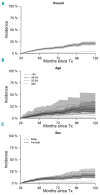Long-term outcome after allogeneic hematopoietic cell transplantation for myelofibrosis
- PMID: 30733269
- PMCID: PMC6717573
- DOI: 10.3324/haematol.2018.205211
Long-term outcome after allogeneic hematopoietic cell transplantation for myelofibrosis
Abstract
Allogeneic hematopoietic stem cell transplant remains the only curative treatment for myelofibrosis. Most post-transplantation events occur during the first two years and hence we aimed to analyze the outcome of 2-year disease-free survivors. A total of 1055 patients with myelofibrosis transplanted between 1995 and 2014 and registered in the registry of the European Society for Blood and Marrow Transplantation were included. Survival was compared to the matched general population to determine excess mortality and the risk factors that are associated. In the 2-year survivors, disease-free survival was 64% (60-68%) and overall survival was 74% (71-78%) at ten years; results were better in younger individuals and in women. Excess mortality was 14% (8-21%) in patients aged <45 years and 33% (13-53%) in patients aged ≥65 years. The main cause of death was relapse of the primary disease. Graft-versus-host disease (GvHD) before two years decreased the risk of relapse. Multivariable analysis of excess mortality showed that age, male sex recipient, secondary myelofibrosis and no GvHD disease prior to the 2-year landmark increased the risk of excess mortality. This is the largest study to date analyzing long-term outcome in patients with myelofibrosis undergoing transplant. Overall it shows a good survival in patients alive and in remission at two years. However, the occurrence of late complications, including late relapses, infectious complications and secondary malignancies, highlights the importance of screening and monitoring of long-term survivors.
Copyright© 2019 Ferrata Storti Foundation.
Figures



References
-
- Gangat N, Caramazza D, Vaidya R, et al. DIPSS Plus: A Refined Dynamic International Prognostic Scoring System for Primary Myelofibrosis That Incorporates Prognostic Information From Karyotype, Platelet Count, and Transfusion Status. J Clin Oncol. 2011;29(4):392–397. - PubMed
-
- Guardiola P, Anderson JE, Bandini G, et al. Allogeneic stem cell transplantation for agnogenic myeloid metaplasia: a European Group for Blood and Marrow Transplantation, Société Française de Greffe de Moelle, Gruppo Italiano per il Trapianto del Midollo Osseo, and Fred Hutchinson Cancer Research Center Collaborative Study. Blood. 1999;93(9):2831–2838. - PubMed
MeSH terms
LinkOut - more resources
Full Text Sources

